Related Research Articles

Kobellite is a gray, fibrous, metallic mineral with the chemical formula Pb22Cu4(Bi,Sb)30S69. It is also a sulfide mineral consisting of antimony, bismuth, and lead. It is a member of the izoklakeite - berryite series with silver and iron substituting in the copper site and a varying ratio of bismuth, antimony, and lead. It crystallizes with monoclinic pyramidal crystals. The mineral can be found in ores and deposits of Hvena, Sweden; Ouray, Colorado; and Wake County, North Carolina, US. The mineral was named after Wolfgang Franz von Kobell (1803–1882), a German mineralogist.
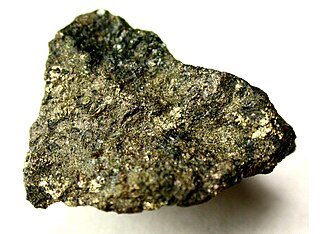
Pentlandite is an iron–nickel sulfide with the chemical formula (Fe,Ni)9S8. Pentlandite has a narrow variation range in nickel to iron ratios (Ni:Fe), but it is usually described as 1:1. In some cases, this ratio is skewed by the presence of pyrrhotite inclusions. It also contains minor cobalt, usually at low levels as a fraction of weight.

Arsenopyrite is an iron arsenic sulfide (FeAsS). It is a hard metallic, opaque, steel grey to silver white mineral with a relatively high specific gravity of 6.1. When dissolved in nitric acid, it releases elemental sulfur. When arsenopyrite is heated, it produces sulfur and arsenic vapor. With 46% arsenic content, arsenopyrite, along with orpiment, is a principal ore of arsenic. When deposits of arsenopyrite become exposed to the atmosphere, the mineral slowly converts into iron arsenates. Arsenopyrite is generally an acid-consuming sulfide mineral, unlike iron pyrite which can lead to acid mine drainage.

Bornite, also known as peacock ore, is a sulfide mineral with chemical composition Cu5FeS4 that crystallizes in the orthorhombic system (pseudo-cubic).
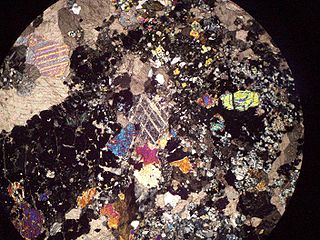
Skarns or tactites are coarse-grained metamorphic rocks that form by replacement of carbonate-bearing rocks during regional or contact metamorphism and metasomatism. Skarns may form by metamorphic recrystallization of impure carbonate protoliths, bimetasomatic reaction of different lithologies, and infiltration metasomatism by magmatic-hydrothermal fluids. Skarns tend to be rich in calcium-magnesium-iron-manganese-aluminium silicate minerals, which are also referred to as calc-silicate minerals. These minerals form as a result of alteration which occurs when hydrothermal fluids interact with a protolith of either igneous or sedimentary origin. In many cases, skarns are associated with the intrusion of a granitic pluton found in and around faults or shear zones that commonly intrude into a carbonate layer composed of either dolomite or limestone. Skarns can form by regional or contact metamorphism and therefore form in relatively high temperature environments. The hydrothermal fluids associated with the metasomatic processes can originate from a variety of sources; magmatic, metamorphic, meteoric, marine, or even a mix of these. The resulting skarn may consist of a variety of different minerals which are highly dependent on both the original composition of the hydrothermal fluid and the original composition of the protolith.
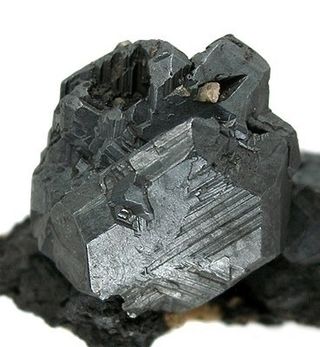
Chalcocite, copper(I) sulfide (Cu2S), is an important copper ore mineral. It is opaque and dark gray to black, with a metallic luster. It has a hardness of 2.5–3 on the Mohs scale. It is a sulfide with a monoclinic crystal system.

Umangite is a copper selenide mineral, Cu3Se2, discovered in 1891. It occurs only in small grains or fine granular aggregates with other copper minerals of the sulfide group. It has a hardness of 3. It is blue-black to red-violet in color with a black streak. It has a metallic luster.

Geocronite is a mineral, a mixed sulfosalt containing lead, antimony, and arsenic with a formula of Pb14(Sb, As)6S23. Geocronite is the antimony-rich endmember of a solid solution series. The arsenic-rich endmember is named jordanite. It occurs as grey, black, to silvery white monoclinic crystals. It is found in hydrothermal veins usually associated with other similar minerals, particularly the sulfides of iron and copper.

Sperrylite is a platinum arsenide mineral with the chemical formula PtAs2 and is an opaque metallic tin white mineral which crystallizes in the isometric system with the pyrite group structure. It forms cubic, octahedral or pyritohedral crystals in addition to massive and reniform habits. It has a Mohs hardness of 6 - 7 and a very high specific gravity of 10.6.

Fukuchilite, Cu
3FeS
8, is a copper iron sulfide named after the Japanese mineralogist Nobuyo Fukuchi (1877–1934), that occurs in ore bodies of gypsum-anhydrite at the intersection points of small masses of barite, covellite, gypsum and pyrite, and is mostly found in the Hanawa mine in the Akita prefecture of Honshū, Japan where it was first discovered in 1969. It occurs in masses within the third geologic unit of the Kuroko type deposits within the mine.

Greigite is an iron sulfide mineral with the chemical formula Fe2+Fe3+2S4. It is the sulfur equivalent of the iron oxide magnetite (Fe3O4). It was first described in 1964 for an occurrence in San Bernardino County, California, and named after the mineralogist and physical chemist Joseph W. Greig (1895–1977).
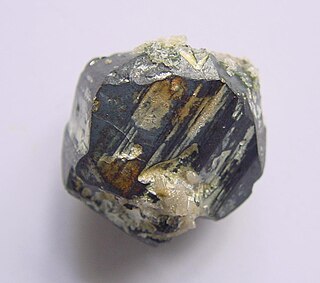
Djurleite is a copper sulfide mineral of secondary origin with formula Cu31S16 that crystallizes with monoclinic-prismatic symmetry. It is typically massive in form, but does at times develop thin tabular to prismatic crystals. It occurs with other supergene minerals such as chalcocite, covellite and digenite in the enriched zone of copper orebodies. It is a member of the chalcocite group, and very similar to chalcocite, Cu2S, in its composition and properties, but the two minerals can be distinguished from each other by x-ray powder diffraction. Intergrowths and transformations between djurleite, digenite and chalcocite are common. Many of the reported associations of digenite and djurleite, however, identified by powder diffraction, could be anilite and djurleite, as anilite transforms to digenite during grinding.

Carrollite, CuCo2S4, is a sulfide of copper and cobalt, often with substantial substitution of nickel for the metal ions, and a member of the linnaeite group. It is named after the type locality in Carroll County, Maryland, US, at the Patapsco mine, Sykesville.

Linnaeite is a cobalt sulfide mineral with the composition Co+2Co+32S4. It was discovered in 1845 in Västmanland, Sweden, and was named to honor Carl Linnaeus (1707–1778).
Fletcherite is a rare thiospinel sulfide mineral with formula Cu(Ni,Co)2S4. It is an opaque metallic steel gray mineral which crystallizes in the cubic crystal system. It is a member of the linnaeite group.

Danalite is an iron beryllium silicate sulfide mineral with formula: Fe2+4Be3(SiO4)3S.
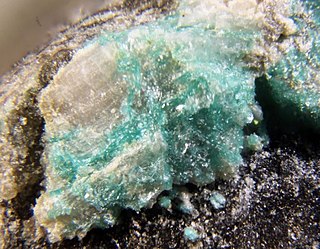
Campigliaite is a copper and manganese sulfate mineral with a chemical formula of Cu4Mn(SO4)2(OH)6·4H2O. It has a chemical formula and also a crystal structure similar to niedermayrite, with Cd(II) cation replacing by Mn(II). The formation of campigliaite is related to the oxidation of sulfide minerals to form sulfate solutions with ilvaite associated with the presence of manganese. Campigliaite is a rare secondary mineral formed when metallic sulfide skarn deposits are oxidized. While there are several related associations, there is no abundant source for this mineral due to its rare process of formation. Based on its crystallographic data and chemical formula, campigliaite is placed in the devillite group and considered the manganese analogue of devillite. Campigliaite belongs to the copper oxysalt minerals as well followed by the subgroup M=M-T sheets. The infinite sheet structures that campigliaite has are characterized by strongly bonded polyhedral sheets, which are linked in the third dimension by weaker hydrogen bonds.

Gilalite is a copper silicate mineral with chemical composition of Cu5Si6O17·7(H2O).

Djerfisherite is an alkali copper–iron sulfide mineral and a member of the djerfisherite group.
Filipstadite is a very rare mineral of the spinel group, with the formula (Mn,Mg)(Sb5+0.5Fe3+0.5)O4. It is isometric, although it was previously though to be orthorhombic. When compared to a typical spinel, both the octahedral and tetrahedral sites are split due to cation ordering. Filipstadite is chemically close to melanostibite. The mineral comes from Långban, Sweden, a manganese skarn deposit famous for many rare minerals.
References
- ↑ Warr, L.N. (2021). "IMA–CNMNC approved mineral symbols". Mineralogical Magazine. 85 (3): 291–320. Bibcode:2021MinM...85..291W. doi: 10.1180/mgm.2021.43 . S2CID 235729616.
- ↑ Dobbe, Rene TM, and Marek A. Zakrzewski. "Oenite, CoSbAs, a new mineral species from the Tunaberg Cu-Co-sulfide skarns, Bergslagen, Sweden." The Canadian Mineralogist 36.3 (1998): 855-860.
- ↑ "Oenite: Oenite mineral information and data". www.mindat.org. Retrieved 2017-12-30.